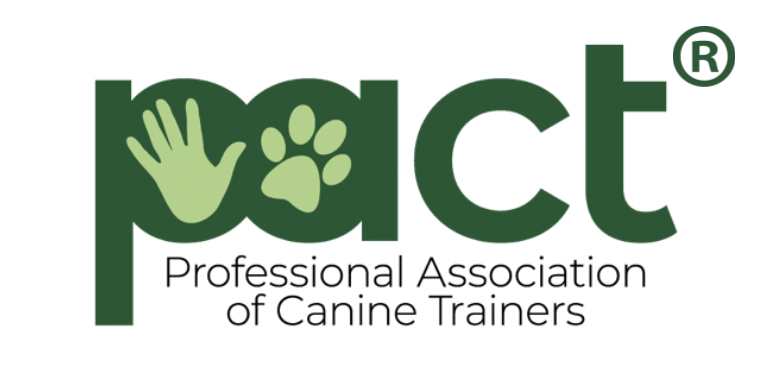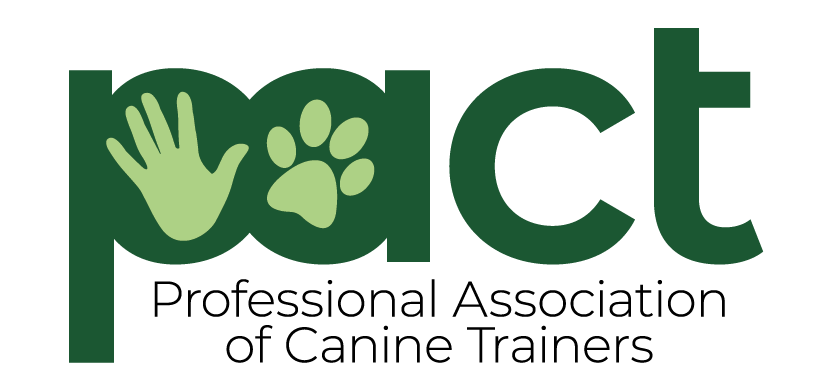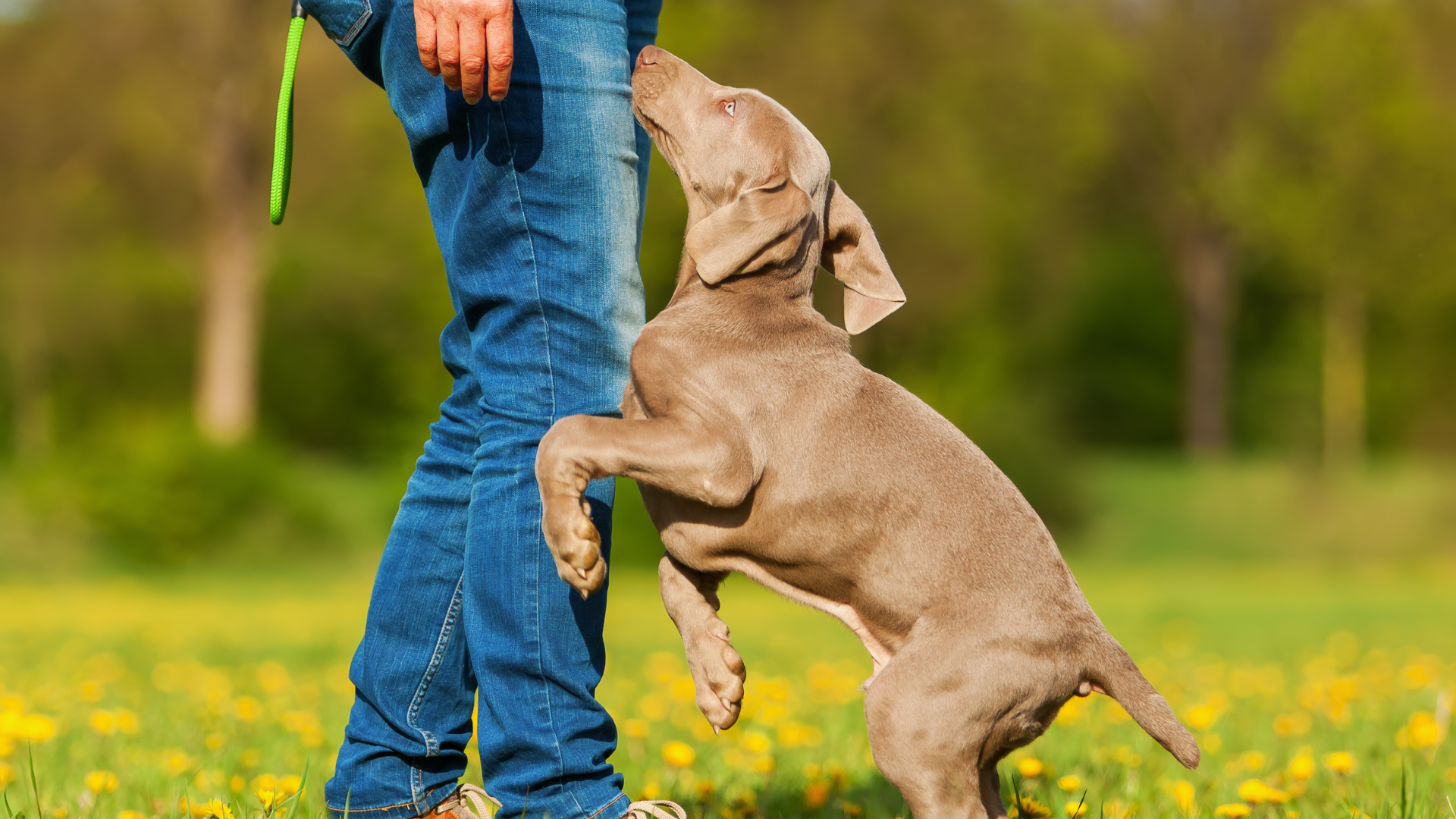Dog Jumping Problems? Here's Your Solution!
When you're a dog trainer it is always advisable, if you'd like a night off thinking about dogs, that you mention to absolutely no one what you do for a living. If you casually slip in, that you are either a trainer or behaviourist, to a conversation that you're having with a stranger at any kind of social event, you are likely to be bombarded with well meaning questions from every angle. The popularity of dogs ensures that around a third of people own dogs in that cocktail party you’re attending, and each of them will have a burning question about why their dog does this? How do I stop my dog doing that? I’ve taken to telling people I work with Military Nanobots and, if ever questioned, I say that my work is top secret and my only advice is to build a concrete bunker in your garden this year and stock up on tins (that may or may not be true).
So today’s PACT Lunch has been designed to give you something you can forward to people who might ask you one of THE most asked questions I get when out in public. How do I stop my dog from jumping on people?
Why on earth are they jumping up?
We must start our journey of 1000 miles with one step grasshopper… If we don’t answer this fundamental question then we are doomed to failure (cue dramatic music). It always comes as a surprise to folks that the primary reason that dogs jump up is simply because they are rewarded for jumping up. If you ever tell someone this they’ll immediately protest telling you that NEVER have they EVER given their dog a slice of Fillet Mingon Steak for jumping on them. Although this may well be true we have to explore further back in time to get to the root of the issue.
Tiny is as Tiny does
When dogs are puppies they are little and the world is big. Add to this that they are irresistibly adorable and smell divine, and you have a recipe for every human (unless they have a heart of concrete) sitting on the floor receiving a million cuddles a day whilst this little, cute rage supplier crawls all over us. It’s impossible to resist and we’ve all been there right? Now you can see just how we might do a bucket load of reinforcing jumping up before we’ve even considered the fallout.
No fault of their own
Then what happens? They stop being so small. We stand up more when greeting them and they still want to get to all the bits of us that mean something – namely our hands and our faces. They’ve had a bazillion instances of being rewarded for crawling up us in the past so why not do it again? Little do they know that now we don’t appreciate that behaviour as much as we did before. Turns out It’s not that appealing having the dewclaw of an adolescent scraping it’s way down our bare leg.
Other reasons
Of course there are other reasons you may see jumping up. Good old fashioned Canine curiosity will always lead to them checking out the sandwich you’ve left on the kitchen side, the smelly treat pouch or the ice cream you happen to be carrying. They may also be worried or even fearful and be looking for reassurance from you.
Is it any wonder?
Add all this together and it’s no wonder they jump up right? Some may even say it’s inevitable! It becomes a “default” behaviour to explore the world on their hind legs (more on default behaviours later). So now we know why let’s get about to how we might approach turning all this around.
Management
“An ounce of prevention is worth a tonne of cure”. “What is practiced gets perfected”. “Practice makes permanent”. There is a reason all these sayings come up a lot in dog training and that reason is because it’s true. It’s truer than true… It’s a fundamental FACT that whatever an animal practices, finds reinforcing will cause an increase in that behaviour. So with that in mind we need to make sure, to the best of our ability, we prevent the behaviour we don’t want, jumping up, from occurring. Use stairgates, leads and harnesses, make sure there is no food on the sides, tell people they can’t say hello to your dog when on walks, as you’re training them to not jump up. All of these are management strategies and we need these in place before moving forward.
What shouldn’t we do?
A quick google still comes up with methods like kneeing a dog in the chest when they jump, or pushing them down with force and shouting NO. All of these are designed to let the dog know they are doing something wrong. I’m here to tell you that although these tactics might “work”, they come at a VERY deep cost. That cost will be to the relationship you have with your dog. So let’s focus on better solutions that will, not only, benefit the relationship but are a whole bucket load less stressful AND will change the way you approach “fixing” behaviours going forward.
Step 1: A new dawn
So we’ve already discussed just how much reinforcement your dog has had for paws leaving the floor. This is what’s known as “reinforcement history” and right now the scales are tipped firmly in the direction of jumping up. What we need to do is start a new reinforcement history going forward and tip those scale to our favour. For this we are going to pick a behaviour that our dogs like to do that has all four paws firmly in contact with the earth. I use a sit with my big old Newfoundland because I’ve observed she is comfortable sitting and chooses this position without being asked to do it. If you’re in any doubt choose an easy position like a “stand” or a “down”, anything that has four paws on the floor. You are then going to work on this position for a solid week before anything else.
Method
Cue the position (ask for the position) and reward heavily with something really tasty. If they stay in position keep popping treats in their gob one after the other for a few reps. Once you feel they are staying in position, waiting for the next morsal you are going to add in a release word (I like the word FREE but you can use anything). Simply say the word out loud and wait… If they move throw a little party and reward them on the floor by your feet. If they don’t move (which is likely at the start) give them a good 10-20 seconds then move yourself. This should encourage them to move out of position and then you throw the party. Continue this training for short, five minute, sessions across the week until it’s solid. Once that is solid you’re going to take it on the road – try it in the garden, try it on walks etc.
Value
This is all about building fantastic value in adopting this position when asked. Be careful not to overdo this. Keep sessions short but practice a few times a day. You’ll be surprised how much can be achieved with short, numerous sessions, even if they’re two minute sessions.
Step Two: Capture those good decisions
The great thing about this next step is that you can be doing this at the same time that you’re working on Step one. Capturing is simple BUT, it requires you to work your observation muscles. As the name suggests, Capturing requires that you notice when the dog is doing the behaviour you would like and leaping into action to make sure you reinforce them for doing it. For example if someone comes in the room and your dog doesn’t jump on them, that’s the time to let them know they’re a good girl, or boy and reach for the, strategically placed, pot of yummies.
Step Three: Learning to greet
Before we go into this I want to point out that some dogs don’t like it when strangers (or even people they know) approach them head on. This can be pretty threatening for dogs. Observe their body language when greeting people they know, to begin with. Do they duck their head if a person reaches out to them? Do they freeze? Do they turn their head, or body away? Do they lick their lips when a person approaches? All these could be signs that they are uncomfortable and if you see these you’ll have to re-think how greetings will go and work towards changing your behaviour and being an advocate for them when out and about. This is when the support of a trainer may benefit you. Click the button below to find an accredited trainer on the PACT & ABTC register.
Assuming that your dog the dog version of Tigger and LOVES people let’s move on and put steps one and two together… We need to start working on some set-ups. After your dog has had a good walk/run arrange for someone (who is capable of following instructions) to come over. Have your dog on a lead and ask for the position. As long as they maintain the position (sit, stand, down) the food shop is open and you will be, periodically, feeding. You’ll have to be sure here that you’re not using the food to keep the dog from jumping up. Take a little time between food treats to observe what the dog is doing. We’re looking for opportunities to reward good decisions (like in the capturing). Perhaps, for example, they look towards the oncoming person but then look back at you whilst maintaining the position. That’s a good decision to reward!
Have the volunteer move towards you a few steps then return. Make sure they don’t get too close to start with. If the dog stay in position keep reinforcing those good decisions as the person approaches. As soon as you see any signs (paddling feet, wiggly bums or any thing else) that shows excitement levels rising, ask the volunteer to move away. This will take time and practice but be persistent and use the little and often rule. Bit by bit the person will be able to get closer and closer.
Once you are at the point where the person can get in the bubble (the area close enough for jumping if they wanted to) but the dog is still calm and focused on you, this is when I’ll use the release word to release them to say hello to the person. They might go to say hello or they might stay with you. Either is fine. They don’t have to say hello if they don’t want to. If they do go over to the person advise that the person remains as calm as possible and goes down to greet them so there is less chance of them jumping up. When it’s time for the person to move away for another go, be sure to call the dog back to you to get them re-focused on you before the person moves off.
If at any point the paws leave the floor two things happen… One, the person stops moving forward and turns around and moves away. Two, the food stops coming and you wait for (or ask for) the position and then then carry on. This will likely require you taking a few steps back and making it easier for the dog next time.
Step Four: Say Hello
Always remember what a dog rehearses they get REALLY good at. That how we ended up in this mess right!? Once the above steps are feeling solid we can move on. This final step is the one I don’t often see done but, I believe, can really seal the deal. With the same set up as before (using a lead or longer line attached to a harness), With your dog in position, have the person approach but stop six feet away. You’re then going to say, to your dog, “Say Hello”, which will mean nothing to them to begin with. Then use your release word and walk towards them. As they get to the person call them back to you and reward them heavily with something extra special! Repeat this process until it becomes an ingrained pattern: “Say Hello”, release, move towards, call back, reward party! Eventually you’re going to say “Say Hello” and when they get to the person instead of calling back you’re going to ask the person the talk to them in a gentle voice then call them back and build on this to the point where the person is touching them by getting down to their level. All the time you’re there to capture the good decisions that your dog is making.
Follow these steps and gradually increase the difficulty by using different people in different locations and you’ll be well on your way.







